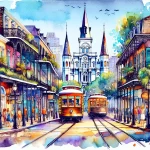New Orleans is a captivating amalgamation of cultures, each strand carefully woven into a tapestry that celebrates life itself with every beat of its heart. From its iconic music scene to its acclaimed cuisine and lively festivities, this city offers a sensory journey unlike any other.
In This Article
TL;DR
- New Orleans blends French, African, Spanish, and Creole influences into a distinctive architectural and cultural landscape.
- The city is globally renowned for its jazz music scene and hosts legendary festivals like Mardi Gras and Jazz Fest.
- Gumbo, jambalaya, and beignets are among the city’s iconic culinary offerings, reflecting its rich history.
The Cultural Fabric of New Orleans
New Orleans‘ culture is a vibrant patchwork quilt, stitched together with threads from various heritages. Initially shaped by French and Spanish rule, the city became a melting pot with the influx of African, Irish, Italian, and Caribbean immigrants. Each group has left an indelible mark on the city’s identity, from the architecture of the French Quarter to the vibrant celebrations of Mardi Gras, which has roots in French Catholic traditions.
Music: The Soul of the City
Jazz, the heart and soul of New Orleans, was born here in the early 20th century, a product of the city’s melting pot of musical influences. The Preservation Hall, established in 1961, remains a testament to the city’s dedication to preserving jazz. The story of jazz is interwoven with the city’s history, evolving through influences like blues and ragtime, and is celebrated annually at the New Orleans Jazz & Heritage Festival.
Festivals: A Year-Round Celebration
In New Orleans, there’s always a reason to celebrate. Beyond the world-famous Mardi Gras, the city’s calendar is dotted with festivals celebrating everything from food to music to local crafts. The French Quarter Festival and the Voodoo Music + Arts Experience showcase the city’s ability to blend music, food, and art, drawing visitors from around the globe.
Culinary Delights
New Orleans’ cuisine is as diverse as its culture. Creole and Cajun dishes dominate, with their roots in French, African, and Spanish traditions. Seafood plays a significant role in local cuisine, with dishes like crawfish étouffée and oyster po’boy. The city’s culinary scene is a direct reflection of its history, with each dish telling a story of cultural exchange and adaptation.
The Architectural Story
Walking through New Orleans, one is transported through time and cultures. The French Quarter, with its Spanish colonial architecture and French-inspired balconies, tells stories of the city’s colonial past. Meanwhile, the Garden District showcases antebellum mansions, reflecting a time of prosperity brought by cotton and sugarcane industries.
Haunted Histories
New Orleans also has a reputation for being one of the most haunted cities in America. The city’s history of tragedy, from fires to floods, has led many to believe that spirits of the past linger. Haunted tours of the French Quarter are popular among tourists and locals alike, adding a layer of mystique to the city’s allure.
FAQ
Q: What is the best time to visit New Orleans for a festival?
A: Spring, particularly April, is ideal as the weather is comfortable, and it coincides with Jazz Fest and the French Quarter Festival.
Q: Can you recommend a traditional New Orleans dish to try?
A: Gumbo is a must-try. This hearty stew typically includes sausage, seafood, and is flavored with a mix of Creole spices.
Q: What are some must-visit places in New Orleans?
A: The French Quarter, for its historical significance; Preservation Hall, for authentic New Orleans jazz; and the National WWII Museum, for a dive into history.
New Orleans is more than just a city; it’s a celebration of diverse cultures and histories, all of which are reflected in its music, food, and festivals. A trip here offers more than just a visual and sensory experience—it’s a journey through the living history and vibrant soul of one of America’s most iconic cities.






